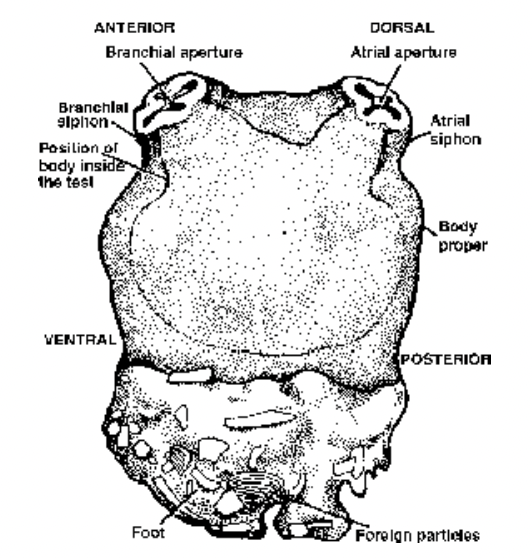Subphylum: Urochordata
Classification of Animal Chordates of Class 11
- Body is unsegmented and usually lacks tail, covered by a test or tunic composed largely of tunicin, allied to cellulose. Appendages absent. (Tunicin is called animal cellulose)
- The notochord is only present in the tail of the larva and disappears in the adult.
- Coelom absent; digestive tract complete
- Respiratory system has two to numerous gill-slits in the pharyngeal wall. Respiratory pigment rich in both Sulphuric acid and Vanadium.
- Circulatory system open; simple tubular ventral heart. It Reverses the direction of its heart beats periodically.
- Nervous system is represented in the adult by a single dorsal ganglion.
- Larva has a hollow nerve cord.
- Excretion is carried on by nephrocytes, pyloric gland or neural gland.

Fig. Herdmania : External features in left view
- Sexes united, always cross and external fertilization; asexual reproduction by budding; some forms exhibit alternation of generation.
- Larva undergoes retrogressive metamorphosis.
- The larva is known as Ascidian tadpole e.g., Herdmania (Sea squirt), Salpa, Doliolum. Pyrosoma (Bioluminiscent) is free swimming while adult is fixed.
- Phylum Chordata
- Sub-Phylum : Hemichordata
- Subphylum: Urochordata
- Subphylum: Cephalochordata
- Subphylum - Vertebrata
- Division-I Agnatha (Jawless Vertebrates)
- Division II : Gnathostomata
- Super Class : Pisces
- Superclass II Tetrapoda
- class Reptilia
- Subclass I Anapsida
- Class Aves
- Flight Adaptations
- Migration of Birds
- Class Mammlia
- Exercise 1
- Exercise 2
- Exercise 3
- Exercise 4
- Exercise 5
- Exercise 6









